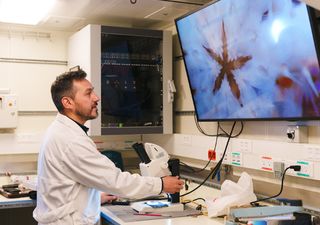First ever archaeological survey in space gives astronauts helpful insights
The findings from the first-ever archaeological survey in space have been published in the journal PLOS ONE, by the research team behind the International Space Station Archaeological Project (ISSAP).

The first archaeological survey in space has given researchers new insights into how astronauts adapt and use their living space aboard the International Space Station (ISS). This research could help with future designs of new space stations ready for when the ISS is eventually decommissioned.
The findings from the first-ever archaeological survey in space have been published in the journal PLOS ONE, by the research team behind the International Space Station Archaeological Project (ISSAP).
Usually, archaeologists on Earth will dig 1-metre squares to understand a site and decide how to study an area further, but, the ISSAP researchers asked the astronauts to use tape to create 1-metre squares of the ISS and then photograph them to be able to see how the spaces were used over 60 days. The squares were made in both work and leisure areas, including the workstations, the U.S galley table, experimental EXPRESS racks and a location across from the latrine where the astronauts would keep their toiletries.
The research team's results help to understand how astronauts adapt to life in zero gravity, how international cooperation happens in a small space and how the station is used for both work and play in space. The team cross-referenced the photos provided with activity logs, and they found that the area located near the exercise equipment and latrine had been used for storage, even though it had no designated purpose. The maintenance area was also only used for storage with little equipment maintenance carried out there.
Furthering extreme habitat archaeology
As well as informing researchers of the future of space habitats, the study’s findings also demonstrate how traditional techniques within archaeology can be adapted for extreme environments, such as Antarctic research stations. ISSAP’s work on this project has won awards from the Archaeological Institute of America and the American Anthropological Associations in 2023.
“Archaeology is not just about the very distant past,” said Justin Walsh, who is a co-founder of Brick Moon, a consultancy in space habitat design and use and archaeologist with Chapman University. “It’s about using objects, artefacts, built spaces and architecture as primary evidence for how humans behave, interpret and adapt to the world around them. Archaeology has a place in space.”
Source of the news:
Walsh, J., Graham, S., Gorman, A.C., Brousseau, C. and Abdullah, S. (2024). Archaeology in space: The Sampling Quadrangle Assemblages Research Experiment (SQuARE) on the International Space Station. Report 1: Squares 03 and 05. PLoS ONE, 19(8), pp.e0304229–e0304229. DOI: https://doi.org/10.1371/journal.pone.0304229








